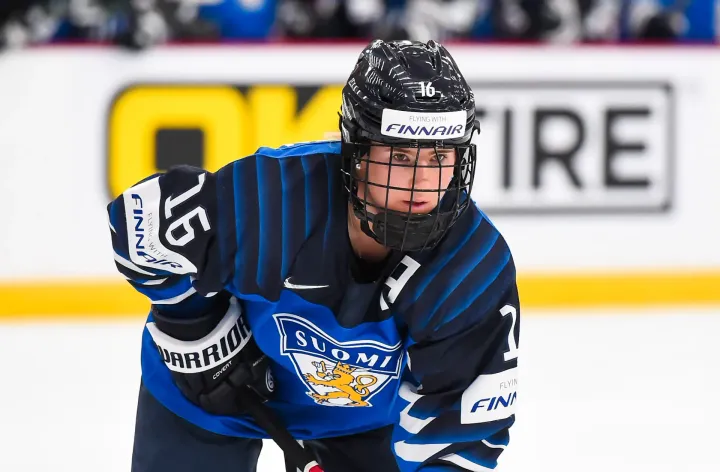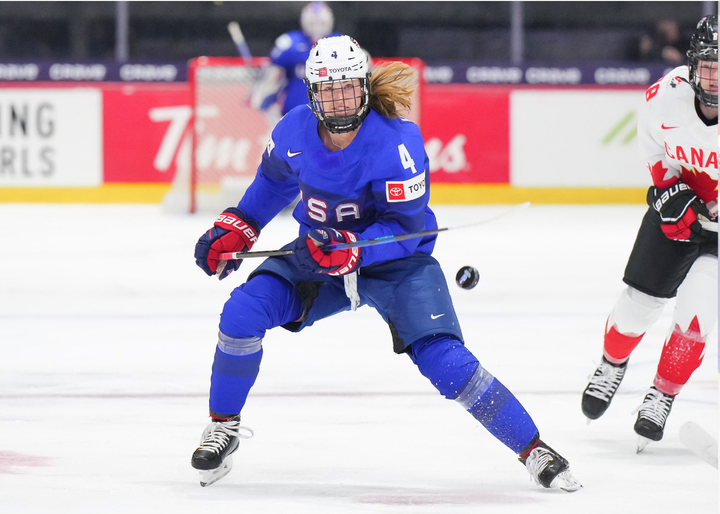Four Nations Report Card: Team USA
A dominant performance results in a fourth-straight Four Nations gold.
Team USA had a lot to prove coming into this tournament, after a close win against Canada at Pyeongchang Olympics in February. They had even more to prove considering the turnovers both on and off the ice: losing Meghan Duggan to injury and both Lamoureux twins to pregnancy as well as head coach Robb Stauber and GM Reagan Carey in a matter of months. Bob Corkum was named the head coach for 2018-2019 at the end of October, so Four Nations was his first real test behind the bench.
Fresh Faces
There were a few healthy players from the Olympic team who weren’t on the roster for Team USA’s trip to Saskatoon: Lee Stecklein of the Buffalo Beauts, Haley Skarupa and Amanda Pelkey of the Boston Pride, and Nicole Hensley of the Buffalo Beauts. The Beauts’ Savannah Harmon and the Riveters’ Michelle Picard were both at pre-tournament camp for Team USA in a “developmental” capacity, but neither defender was on the final roster.
The new additions included forward Melissa Samoskevich of Quinnipiac University, defender Mikaela Gardner of Wisconsin, forward Sydney Brodt of Minnesota-Duluth, forward Caitrin Lonergan of Boston College, and goalie Emma Polusny of St. Cloud State. A few players returned to the senior team, including Megan Bozek of the Markham Thunder, Alex Rigsby of the Calgary Inferno, and Annie Pankowski of Wisconsin.
In spite of the turnover, Team USA was dominant at this tournament, going undefeated throughout all four games. They outscored their opponents 17 to 4, scored 5 goals in three of their games, and only allowed more than one goal in their final game (a 5-2 win over Team Canada). Their penalty kill was almost bulletproof at 91%, falling short of perfect only due to Canada’s powerplay goal in the gold-medal game--which is good, because they took 32 penalty minutes, 2 more than the next closest team.
pretty low key start to the third period. as not a ton happened, except for kacey bellamy butt checking, i mean body checking, a swed pic.twitter.com/N01CJMDAfY
— The Ice Garden (@TheIceGarden) November 9, 2018
Team USA has proven they’ve retained their ability to win, and win big. Still, there’s plenty for coach Corkum to work on before the World Championships in the spring.
New Kids On The Block
A few of the rookies really made statements this tournament. Perhaps most notably, Sydney Brodt had a monster tournament, with three goals and two assists for a total of five points in four games. She was immediately placed onto a line with Kendall Coyne-Schofield and Brianna Decker, linemates who could feed her in front of the net and make use of her innate knack for good positioning.
Samoskevich's goal pic.twitter.com/5WvsfJ4xRW
— The Ice Garden (@TheIceGarden) November 11, 2018
Melissa Samoskevich made her presence felt in the last two games, scoring in each. Her first-ever senior team goal was a shorthanded one against Team Sweden, and she scored Team USA’s second goal in the gold-medal game on Saturday night. Both of her linemates, Kelly Pannek and Amanda Kessel, ended the game with only an assist each, but Samoskevich’s hustle and physical play set her apart after she had a few games to get comfortable.
Someone was pumped for Emma Polusny's first win in her first NT game. @kbells22 pic.twitter.com/TgldA9v63Q
— Eleni 🤗 (@strongforecheck) November 9, 2018
Polusny got her first win in her first start, and only let in one goal, a snipe that almost any goalie would have had trouble with. Lonergan, who is prolific at BC, had the primary assist on Hilary Knight’s goal against Finland, but was otherwise quiet this tournament. Gardner and Lonergan were both on the ice for Finland’s goal, which resulted from defensive miscues that left both facing the net when the shot was taken.
Gardner certainly seemed to grow more comfortable as the tournament went on, throwing herself into the dirty areas and fighting for the puck behind her own net, but ended the tournament without her first national team point.
Scoring Patterns
Part of Team USA’s success this tournament surely came from the fact that the team did not have to rely on only one line to generate scoring. In the past, especially during last year’s The Time Is Now Tour, that no goals were scored unless the top line of Coyne-Decker-Knight was producing. Corkum broke this line up, and the result was two lines that consistently generated high-danger chances and found their way onto the scoresheet.
Knight-Brandt-Cameranesi combined for seven goals (Knight’s three, Cameranesi’s two, and Brandt’s two) and nine assists (Knight’s four, Cameranesi’s four, Brandt’s one). This line is a nightmare to defend against, between their physicality and puck movement. Coyne-Decker-Brodt also combined for seven goals (Brodt’s three, Decker’s three, Coyne’s one) and nine assists (Brodt’s two, Decker’s three, Coyne’s four). The speed on this line allowed them to get behind defenders and set up back-and-forth sequences that more than once resulted in a nice easy tap-in. Having these two equally lethal lines makes defensive matchups impossible, and it showed.
Most of the goals came from forwards, as Barnes was the only defender with a goal this tournament. Bellamy, Pfalzer, Keller and Flanagan all had assists, while Morin led all defenders in scoring with two.
Thank U, Next
So, with a performance this good, where are the holes that need to be patched up?
For starters, Team USA’s powerplay was a non-event. They only scored one powerplay goal all tournament, although they had fifteen shots to do so (not including a Canadian penalty that began a 4 on 4). They seemed to have trouble setting up, and when they did, it seemed as though they were hesitant to shoot. It was also unclear whether there were set powerplay units. At times it seemed as though Corkum was just playing his regular lines. It will be important moving forward to develop strategies and units dedicated specifically to the powerplay, especially facing Canada, who took nearly as many penalties as Team USA (30 PIM to the USA’s 32).
A potentially easier issue to resolve is the status of Team USA’s leadership core. In Pyeongchang, Duggan wore the C, with Decker and Bellamy wearing A’s. The team began the tournament without any letters at all, and Marvin took the ceremonial puck drop against Finland. From the second game onward, Decker had the C, but there were no players wearing A’s. During the celebration after the gold-medal game, Knight and Marvin joined Decker with the cup, then seemed to be looking and calling for Bellamy, so there seems to be some confusion about who is or isn’t in that assistant captain role. Perhaps in the future we will see the three of them rotate A’s, much like Canada’s Daoust, Jenner, and Larocque.
The last one is maybe less of an actual problem, but it does pose some questions. All three goalies were solid during this short tournament, and all of them got at least one game. After the gold-medal game in Pyeongchang, it might have surprised some fans to see Rigsby start the Four Nations final over Rooney, but she proved that she can backstop the team to an important win. In Hensley, Rigsby, and Rooney, Team USA already has three experienced international goalies, any one of which could reliably carry the team through a gold-medal game.
This creates a problem when considering young goalies like Polusny, and she’s not alone. There are players around the NCAA who you could argue ‘deserve’ a look at the senior team, and even some in the pros- the Pride’s Katie Burt and the Riveters’ Katie Fitzgerald, for example. Luckily, the coaching staff has four years to decide on a go-to number one.
Final Grade: A
Statistics used in this article were taken from Hockey Canada’s 4 Nations page and individual tracking.





Comments ()